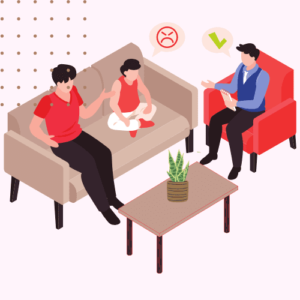
Abusive Partner Test
Answer these simple questions to understand more about your Abusive Partner. We share instant results and keep your information confidential.

What is Abusive Partner Test?
The Abusive Partner Test is not an official diagnostic tool but rather a series of questions and assessments designed to help individuals evaluate the dynamics of their romantic relationships for signs of abuse. It typically includes questions about emotional, physical, or psychological mistreatment, control, manipulation, and intimidation within the relationship. The test aims to raise awareness about unhealthy relationship patterns, providing a framework for individuals to assess whether they might be experiencing abuse or engaging in abusive behavior. It encourages seeking help, support, or counseling if abusive patterns are identified, ultimately promoting safer and healthier relationships. It’s important to consult professionals for a proper evaluation and guidance in abusive situations.
Who can benefit from this Abusive Partner Test?
The Abusive Partner Test is a valuable tool designed to benefit individuals who suspect they may be in an abusive relationship or want to assess the health of their current partnership. It can also be beneficial for friends and family concerned about a loved one’s well-being. This test helps raise awareness about various forms of abuse, including emotional, physical, or psychological, enabling individuals to recognize the signs and seek appropriate help or support. Moreover, it educates users on healthy relationship dynamics, promoting early intervention, and facilitating informed decisions about staying, seeking counseling, or leaving a harmful relationship, ultimately fostering safer and more fulfilling connections.


Abusive Partner Test Accuracy
The accuracy of an abusive partner test, or any similar assessment, can vary widely depending on factors like the test’s design, the honesty of the respondent, and the context in which it is administered. While such tests may provide valuable insights into potential abusive behavior, they are not foolproof. False positives and negatives can occur, impacting accuracy. The effectiveness also depends on the test’s sensitivity and specificity. Seeking professional help or counseling remains crucial for anyone concerned about an abusive relationship, as trained experts can provide a more comprehensive assessment and guidance on the appropriate course of action for their specific situation.
Types of Assessment to Measure Abusive Partner Test
Domestic Violence Risk Assessment:
These assessments are typically conducted by trained professionals, such as therapists, counselors, or law enforcement officers. They involve a comprehensive evaluation of an individual’s history and current behavior to assess the risk of abusive behavior.
Questionnaires and Surveys:
Various questionnaires and surveys have been developed to assess abusive behavior in relationships. Examples include the Conflict Tactics Scale (CTS) and the Abuse Assessment Screen (AAS).
Clinical Interviews:
Mental health professionals may conduct clinical interviews to assess abusive behavior. They ask open-ended questions to gain insight into the individual’s behavior, emotions, and thoughts within the context of their relationships.
Observational Assessment:
Trained professionals may observe interactions between partners to assess for signs of abusive behavior. This can be especially useful in situations where individuals may not be forthcoming about their behavior during interviews or surveys.
Psychological Testing:
Specific psychological tests may be used to assess personality traits and psychological factors that could contribute to abusive behavior. These tests can help professionals gain a deeper understanding of the individual’s mental state.
Risk Assessment Tools:
Various risk assessment tools have been developed to evaluate the likelihood of future abusive behavior, such as the Danger Assessment or the Ontario Domestic Assault Risk Assessment (ODARA).
Handling Abusive Partner
Handling an abusive partner is a challenging and often dangerous situation. It’s important to prioritize your safety and well-being. Here are some steps you can take if you find yourself in an abusive relationship:
- Assess Your Safety: The most important thing is your safety. If you are in immediate danger, call emergency services (911 in the United States) or your local emergency number. If you can’t talk freely, leave the line open so the operator can hear what’s happening.
- Reach Out for Support: Confide in someone you trust, such as a close friend, family member, or counselor. You don’t have to face this situation alone, and they can provide emotional support and help you make a plan.
- Create a Safety Plan: Develop a safety plan for yourself and any dependents. This may include identifying a safe place to go if you need to leave quickly, having a bag with important documents, money, and necessities ready, and setting up a code word or signal with a friend or family member to indicate when you’re in danger.
- Contact a Domestic Violence Hotline: In many countries, there are domestic violence hotlines you can call or chat with online for immediate support and resources. They can provide guidance and help you understand your options.
- Legal Protection: If you feel comfortable doing so, consider getting a restraining order or protective order against your abusive partner. Consult with a lawyer or a local domestic violence agency for assistance with this process.
- Seek Professional Help: Reach out to a therapist or counselor who specializes in domestic abuse. They can provide you with strategies for coping and healing, as well as help you work through the emotional trauma.
- Build a Support Network: Cultivate a network of friends and family who can provide emotional support and practical assistance. You may need help with transportation, childcare, or other aspects of daily life.
- Financial Independence: If possible, work on becoming financially independent from your abusive partner. This may involve finding a job or seeking financial assistance through government programs or non-profit organizations.
- Consider a Shelter: If you have nowhere safe to go, consider contacting a domestic violence shelter. They can provide temporary housing and support services.
- Educate Yourself: Learn about the cycle of abuse, types of abuse (physical, emotional, financial, etc.), and signs of escalation. Knowledge is power, and understanding what you’re dealing with can help you make informed decisions.
- Know Your Rights: Familiarize yourself with your legal rights and protections as a survivor of domestic abuse. Laws vary by location, so consult with a lawyer or local domestic violence agency for guidance.
- Plan for the Future: Develop a long-term plan for your safety and well-being. This may involve seeking a new place to live, pursuing education or job training, and building a life free from abuse.
Remember that leaving an abusive relationship can be extremely difficult, and it’s essential to have a support system in place. If you’re concerned about your safety, consult with professionals who can guide you through the process. Your safety and well-being are the top priorities.